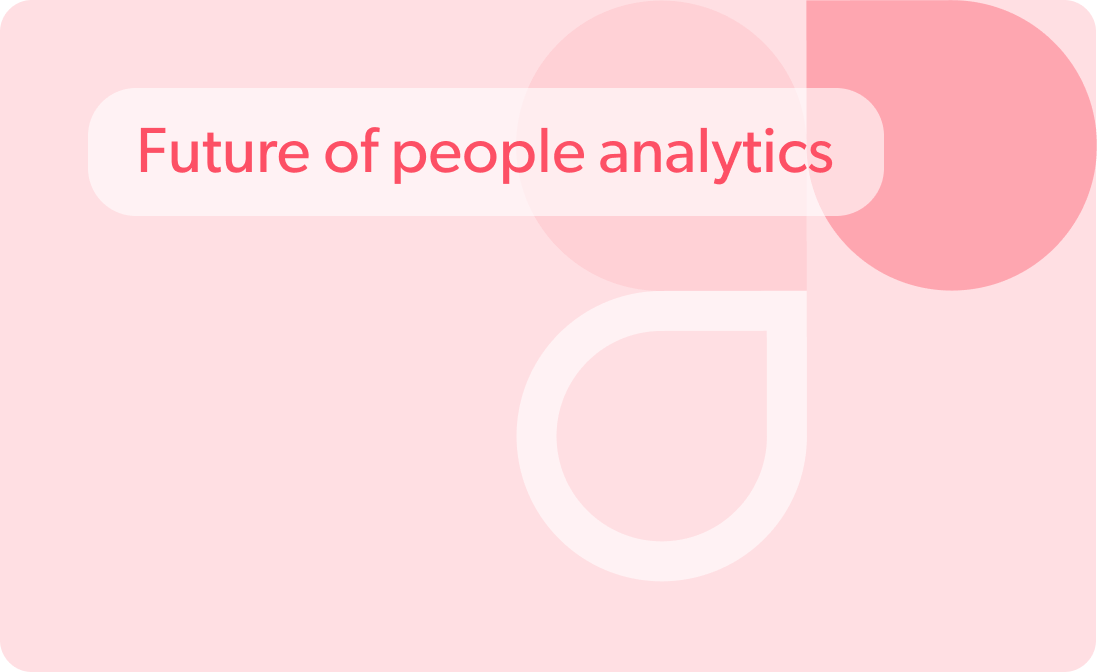Roxanne Laczo on shaping talent programs for organizational growth
Table of contents
- Where does people analytics belong in the organization? What’s the main role of people analytics in the organization?
- How can people analytics help with talent acquisition, retention, and employee engagement?
- What data sources are typically used in people analytics?
- What skills and expertise are required to work in people analytics?
- Do you use any tools or technologies for your work?
Meet Roxanne Laczo, who has built and led people analytics teams at both multinational and high-growth organizations. Roxanne is known for her global expertise in shaping talent programs that drive organizational growth. An influential leader, she’s adept at leading cross-functional initiatives with senior stakeholders, including the C-suite.
In this interview, we delved into the role, importance, and methods of people analytics within organizations. We also touched upon data utilization in HR decisions, the significance of a robust statistical foundation, tools, and technologies, and benchmarking people analytics practices against competitors.
Q: Where does people analytics belong in the organization? What’s the main role of people analytics in the organization?
I think people analytics has a twofold purpose:
- One, the more common definition of people analytics, is the collection and application of workforce and talent data to help businesses make better decisions.
- What’s missing is this secondary piece around strategic and statistically sound measurement and talent assessment with research-based systems, programs, etc. I think it’s not only using the data that you currently have to help businesses and HR teams make better decisions, but I think it’s also around having a solid foundation of measurement in terms of how you develop programs and how you measure the success of programs.
Are you using psychometrically valid and statistically sound metrics when assessing programs to ensure that the insights you deliver are based on a solid research foundation?
Q: How can people analytics help with talent acquisition, retention, and employee engagement?
People often associate people analytics primarily with metrics like ‘time to fill‘ or ‘headcount.’ However, its scope extends much further. A fundamental aspect is ensuring a robust psychometric and statistical foundation.
Talent acquisition is not just about measuring how long someone remains in the recruitment pipeline. It’s about verifying if your assessment process is statistically valid.
- Are your interviews standardized?
- Are your interviewers trained to ensure fairness and equity?
While many focus on these basic metrics, there’s a deeper layer to people analytics that’s equally crucial.
This in-depth approach applies across the talent lifecycle, from an individual’s initial contact with the organization as a candidate to their exit as an alumnus. Each phase and every employee-related activity should stand on a firm analytical foundation.
When evaluating employee engagement, decades of research have been dedicated to crafting statistically sound surveys. Books detail how to create effective survey questions, and psychometrics guide the number of questions per section. Confirming that your metrics possess internal validity, reliability, and consistency is pretty essential. Linking these metrics is vital.
For example
One should establish connections to employee engagement when considering talent acquisition and onboarding. It’s worth examining if activities during onboarding impact future engagement. Does an initial meeting with a manager influence an employee’s subsequent experience?
Engagement surveys are crucial as they can preemptively indicate potential issues. For example, understanding why certain employee groups leave can inform your talent acquisition strategy. If a goal is to hire more women in leadership roles, assessing engagement and retention strategies for female employees is imperative. Observing exit rates can further refine this approach.
It’s essential to realize that all these facets are interconnected. Yet, many analytics or HR teams examine them in isolation. A holistic approach to an integrated talent management strategy is crucial, ensuring each component influences and refines the others.
Q: What data sources are typically used in people analytics?
The data sources used in people analytics can vary extensively, depending largely on an organization’s technological maturity and available tools, both internal and external.
Most organizations utilize an HRIS (Human Resource Information System) at the foundational level. For instance, companies I have worked for recently use Workday, but many companies opt for systems like Success Factors. Another cornerstone is the ATS (Applicant Tracking System), which includes platforms like Taleo, Greenhouse, and ICIMS. These are pivotal for comprehensive insights across the employee lifecycle.
Platforms like Workday offer embedded tools for measuring engagement and conducting surveys. However, many businesses employ external vendors for this purpose. Beyond the HRIS and ATS, several organizations rely on employee experience or engagement measurements tracking systems like Qualtrics, Perceptyx, Glint, or Culture Amp. These tools often allow integration or uploading of external data types.
Mature people analytics teams often upload their HRIS data into these systems and, importantly, integrate business outcome data. Sales data, being commonly available, is a notable example. Linking sales data to performance evaluations, quality of hire assessments, or potential evaluations can provide invaluable insights. For example, understanding the performance and retention of top-performing sales associates can guide talent acquisition and retention strategies.
Other significant data sources include financial data or data from platforms like Salesforce. Any metric related to employee evaluation can serve as a foundational data source.
As for how these data sources are utilized, it can vary. They might be used independently or integrated. Several companies opt for cloud-based solutions that amalgamate all the data. However, the approach largely depends on the company’s specific needs, IT systems, and the in-house BI (Business Intelligence) teams — determining what they have, should develop, and might need to procure externally.
Q: Today‘s labor world is interdisciplinary. If we’re talking about people analytics, what skills and experience are required, for example, to work there?
I’ve based my model on years of experience and insights from other leaders. While not everyone may agree, leaders should excel in some areas while ensuring their teams cover all of them. Here are my four primary dimensions:
- Content and theory. As an IO psychologist, I firmly believe in the importance of someone with an IO psychology background playing a key role on any people analytics team. While someone from a technical, BI, or consulting background might excel in structuring questions and integrating data, they might lack knowledge about the underlying theories. For instance, understanding how to develop an effective structured interview process or the psychometric property of a survey ensures fairness and equity. Grounding our analytics in theory and research elevates our insights beyond mere numbers.
- Statistics and analytics. While not everyone needs to be a data scientist, a basic understanding of measurement theory is critical. Recognizing a statistically significant difference, segmenting data meaningfully, and employing predictive modeling is essential. Depending on the company’s maturity and infrastructure, there might be a varying appetite for such analytics.
- Data and systems. Many people analytics teams emphasize this dimension but thought leadership is also necessary. This category covers HRIS management, data warehousing, data privacy like GDPR, and data visualization. Knowing and complying with data privacy regulations is pivotal, especially with varied regulations in different countries.
- Consulting and influencing. For more mature companies, people analytics leaders must engage in strategic discussions with business partners and leaders. Understanding business problems, building relationships, and crafting compelling stories are all part of this dimension. Change management, stakeholder management, and story-telling capabilities are crucial.
Interestingly, a potential fifth dimension is emerging: Generative AI. With advancements in AI, companies are adjusting their expectations. Tools like ChatGPT and Midjourney exemplify this shift. The role of AI in people analytics will likely evolve, shaping the landscape.
Many people perceive analytics as purely data-driven. However, background plays a role in this perspective.
With AI’s rising prominence, tools like ChatGPT and Midjourney prove invaluable for rapid analytics. The integration of AI is the future. In terms of hard and soft skills, I’ve delineated them through these dimensions.
Q: Do you use any tools or technologies for your work?
I am in a distinct position as I work for an organization that emphasizes using available tools and technologies or ones we can develop in-house. While many firms opt for services from companies like Visier, OneModel, or equitable for their people analytics tools, our approach is different. We heavily rely on Tableau internally – which has its challenges but serves the basic purpose we need it to.
Our team has constructed an in-house people data warehouse in collaboration with a data engineer and our BI unit.
This central hub integrates data from Workday, Greenhouse, and Salesforce. Tableau is our primary dashboarding, data visualization, and dissemination tool.
Although Tableau may not offer the most advanced insights, it’s a significant leap forward considering our previous state, where we lacked a structured system or faced numerous issues. Now, we can access a range of dashboards, from workforce composition to talent management and sales data.
As we grow and evolve, we might have to reconsider whether Tableau remains our best option or if another solution becomes more apt.
A straightforward part of our toolset is Perceptyx for surveys.
They’ve recently enhanced their offerings by acquiring AI-focused companies like Cultivate AI and Humu, specializing in manager effectiveness. These acquisitions are set to revolutionize how firms, including ours, gauge employee experiences. Tableau and Perceptyx are core tools that meet our current organizational needs.
Companies with different priorities and resources might lean towards cloud-based tools, which I acknowledge are impressive.
For instance, I’m an advisor for the Eqtble team and wholly support their mission. For firms that fit their profile, partnering with such companies can save significant time and effort.
Q: Do you use any tools or technologies for external data, perhaps to benchmark competitors or to understand how companies in your business sector handle their people analytics compared to yours?
I understand that companies like Insight222, which specialize in people analytics consulting, undertake comprehensive surveys and analyses to paint a picture of the current landscape. These consulting firms produce yearly surveys, and benchmarks are available, such as PwC Saratoga, if you can invest in those tools. Prominent firms like Deloitte and McKinsey also release extensive reports on the subject. Harvard Business Review has contributed articles in this domain as well. These consulting firms collate competitive intelligence and information to present an overview. The focus isn’t necessarily on which teams excel or lag; it’s more about showcasing the percentage of companies at various stages and the practices of more successful teams.
For example
A general observation is that the most successful people analytics teams report directly to the CHRO. Any deviation from this hierarchy may indicate that the leadership team doesn’t grasp the value of people analytics.
Addressing your earlier question about where people analytics fits in an organization, many companies have centralized analytics departments that house various teams, including marketing, IT, and people analytics. This structure can be advantageous, especially for a people analytics leader without a deep technical background. It provides exposure to technical elements and facilitates connections with other analytics groups in the company. Being embedded within the business makes interacting with other analytics teams and sharing insights consistently challenging.
Stay up to date with our newsletter
Every month, we’ll send you a curated newsletter with our updates and the latest industry news.


























 info@hrforecast.de
info@hrforecast.de
 +49 89 215384810
+49 89 215384810






